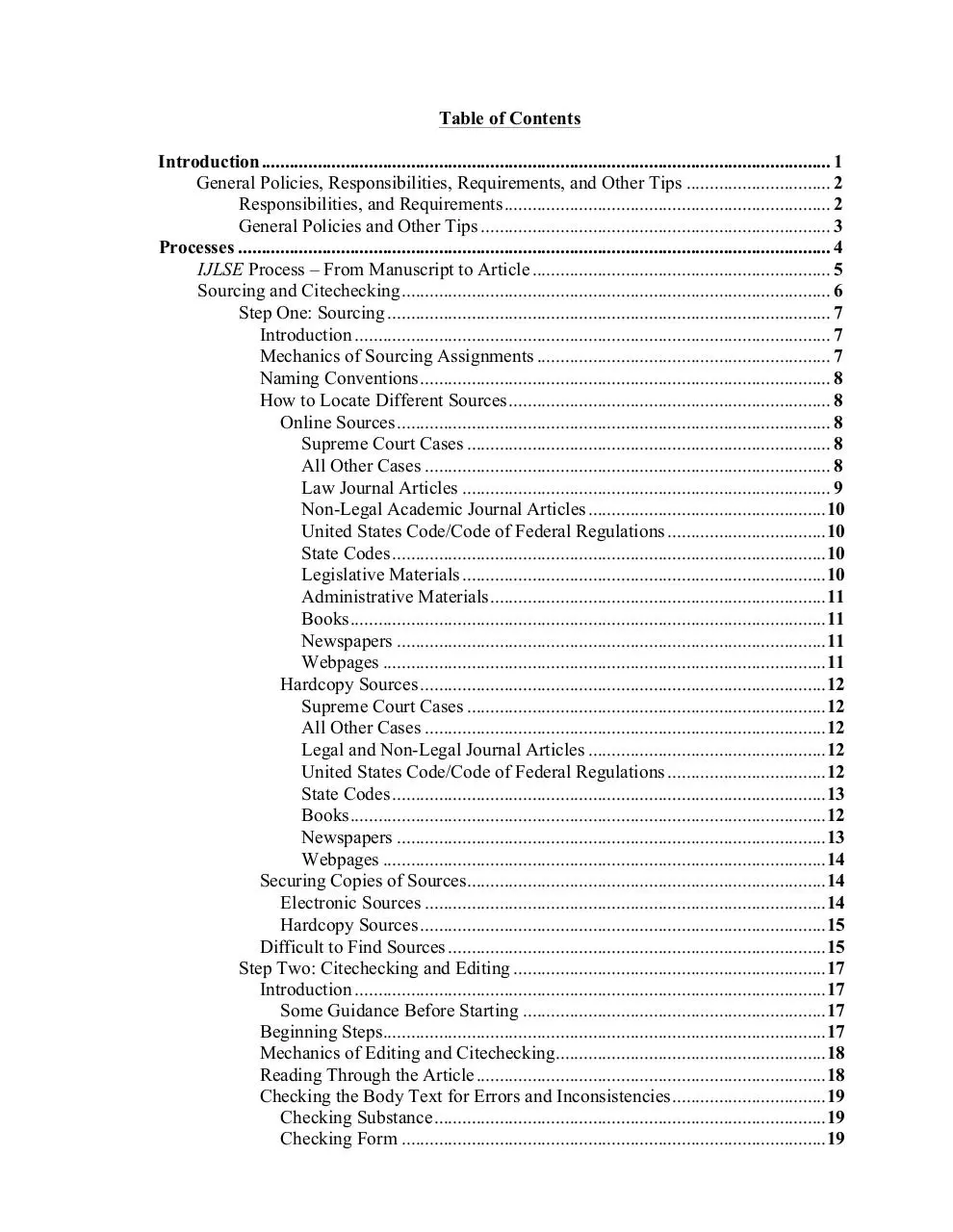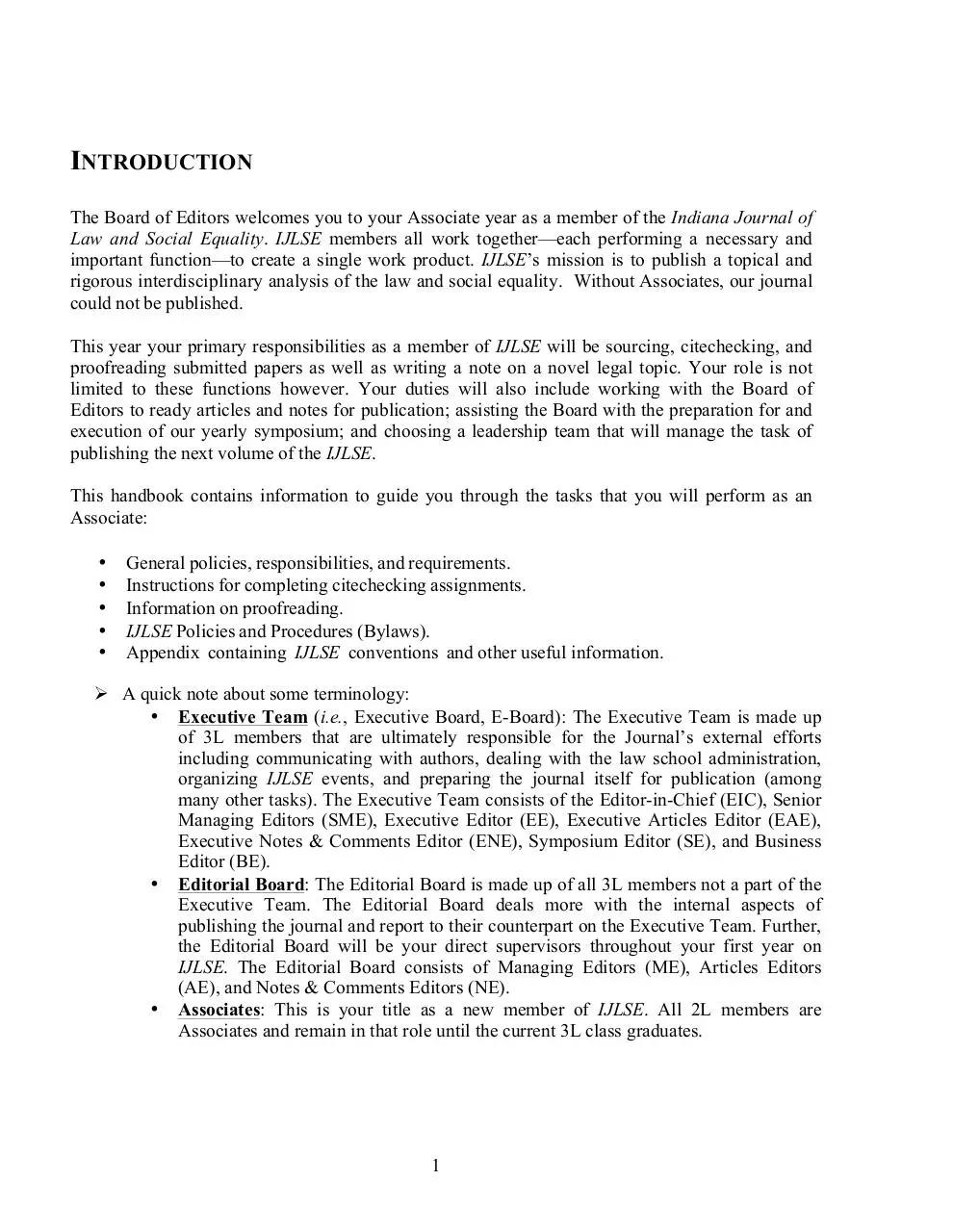IJLSE handbook 8212015 (PDF)
File information
Title: Microsoft Word - IJLSE_handbook_8212015.docx
This PDF 1.3 document has been generated by Word / Mac OS X 10.10.4 Quartz PDFContext, and has been sent on pdf-archive.com on 12/09/2015 at 19:27, from IP address 156.56.x.x.
The current document download page has been viewed 849 times.
File size: 4.17 MB (68 pages).
Privacy: public file





File preview
Indiana Journal of Law and Social Equality
Volume 4
2015−2016
ASSOCIATE’S HANDBOOK
§§
§§
§§
§§
PROCESSES
POLICIES AND PROCEDURES
IJLSE BYLAWS
REFERENCE APPENDIX
Last Updated 8/21/2015
Table of Contents
Introduction .......................................................................................................................... 1
General Policies, Responsibilities, Requirements, and Other Tips ............................... 2
Responsibilities, and Requirements ...................................................................... 2
General Policies and Other Tips ........................................................................... 3
Processes ............................................................................................................................... 4
IJLSE Process – From Manuscript to Article ................................................................ 5
Sourcing and Citechecking ............................................................................................ 6
Step One: Sourcing ............................................................................................... 7
Introduction ...................................................................................................... 7
Mechanics of Sourcing Assignments ............................................................... 7
Naming Conventions ........................................................................................ 8
How to Locate Different Sources ..................................................................... 8
Online Sources ............................................................................................. 8
Supreme Court Cases .............................................................................. 8
All Other Cases ....................................................................................... 8
Law Journal Articles ............................................................................... 9
Non-Legal Academic Journal Articles ...................................................10
United States Code/Code of Federal Regulations ..................................10
State Codes .............................................................................................10
Legislative Materials ..............................................................................10
Administrative Materials ........................................................................11
Books ......................................................................................................11
Newspapers ............................................................................................11
Webpages ...............................................................................................11
Hardcopy Sources .......................................................................................12
Supreme Court Cases .............................................................................12
All Other Cases ......................................................................................12
Legal and Non-Legal Journal Articles ...................................................12
United States Code/Code of Federal Regulations ..................................12
State Codes .............................................................................................13
Books ......................................................................................................12
Newspapers ............................................................................................13
Webpages ...............................................................................................14
Securing Copies of Sources.............................................................................14
Electronic Sources ......................................................................................14
Hardcopy Sources .......................................................................................15
Difficult to Find Sources .................................................................................15
Step Two: Citechecking and Editing ...................................................................17
Introduction .....................................................................................................17
Some Guidance Before Starting .................................................................17
Beginning Steps...............................................................................................17
Mechanics of Editing and Citechecking..........................................................18
Reading Through the Article ...........................................................................18
Checking the Body Text for Errors and Inconsistencies .................................19
Checking Substance ....................................................................................19
Checking Form ...........................................................................................19
Checking the Citations ....................................................................................20
Setting Up Your Citechecking Report from the Template .........................20
Checking Substance ....................................................................................21
Highlighting PDFs..................................................................................21
Flagging Books and Other Non-Electronic Sources ..............................21
Checking Form ...........................................................................................22
Finishing Up ....................................................................................................22
Post-Citechecking............................................................................................22
Step Three: Proofreading .....................................................................................23
Introduction .....................................................................................................23
Proofreading Procedure ...................................................................................23
Individual Proofreading ..............................................................................24
Team Proofreading .....................................................................................24
Tips for Effective Proofreading.......................................................................25
IJLSE Bylaws .........................................................................................................................
Section 1 – Introduction ................................................................................................ i
Section 2 – Executive Team .......................................................................................... i
Section 3 – Board of Editors ......................................................................................... ii
Section 4 – Associates ................................................................................................... iii
Section 5 – Notes and Comments .................................................................................. iv
Section 6 – Discipline .................................................................................................... v
Section 7 – Elections and Transition ............................................................................. vi
Reference Appendix .................................................................................................................
Appendix A: IJLSE Conventions .................................................................................A-1
Appendix B: Commonly Overlooked Bluebook and CMS Rules .................................A-5
Bluebook Rules ....................................................................................................A-5
Chicago Manual of Style Rules ...........................................................................A-6
Compounds & Hyphens .................................................................................A-6
Commas ..........................................................................................................A-9
Semicolons ................................................................................................... A-10
Parallelism .................................................................................................... A-11
Prepositions & Prepositional Phrases ........................................................... A-11
Infinitives ...................................................................................................... A-12
Subject/Verb Agreement .............................................................................. A-12
Appendix C: Accessing the Z-Drive from your Computer ........................................ A-13
Appendix D: Sample InterLibrary Loan Request Form ............................................. A-16
Appendix E: Sample Written Citechecking Reports .................................................. A-18
Appendix F: Sample Redline...................................................................................... A-21
Appendix G: Sample Source List .............................................................................. A-22
Appendix H: Tips for Locating Difficult Pincites ...................................................... A-23
Appendix I: Citechecking Checklist ........................................................................... A-25
Appendix J: Finding Legislative Documents with ProQuest ..................................... A-28
Appendix K: Staff Information .................................................................................. A-29
INTRODUCTION
The Board of Editors welcomes you to your Associate year as a member of the Indiana Journal of
Law and Social Equality. IJLSE members all work together—each performing a necessary and
important function—to create a single work product. IJLSE’s mission is to publish a topical and
rigorous interdisciplinary analysis of the law and social equality. Without Associates, our journal
could not be published.
This year your primary responsibilities as a member of IJLSE will be sourcing, citechecking, and
proofreading submitted papers as well as writing a note on a novel legal topic. Your role is not
limited to these functions however. Your duties will also include working with the Board of
Editors to ready articles and notes for publication; assisting the Board with the preparation for and
execution of our yearly symposium; and choosing a leadership team that will manage the task of
publishing the next volume of the IJLSE.
This handbook contains information to guide you through the tasks that you will perform as an
Associate:
•
•
•
•
•
General policies, responsibilities, and requirements.
Instructions for completing citechecking assignments.
Information on proofreading.
IJLSE Policies and Procedures (Bylaws).
Appendix containing IJLSE conventions and other useful information.
Ø A quick note about some terminology:
• Executive Team (i.e., Executive Board, E-Board): The Executive Team is made up
of 3L members that are ultimately responsible for the Journal’s external efforts
including communicating with authors, dealing with the law school administration,
organizing IJLSE events, and preparing the journal itself for publication (among
many other tasks). The Executive Team consists of the Editor-in-Chief (EIC), Senior
Managing Editors (SME), Executive Editor (EE), Executive Articles Editor (EAE),
Executive Notes & Comments Editor (ENE), Symposium Editor (SE), and Business
Editor (BE).
• Editorial Board: The Editorial Board is made up of all 3L members not a part of the
Executive Team. The Editorial Board deals more with the internal aspects of
publishing the journal and report to their counterpart on the Executive Team. Further,
the Editorial Board will be your direct supervisors throughout your first year on
IJLSE. The Editorial Board consists of Managing Editors (ME), Articles Editors
(AE), and Notes & Comments Editors (NE).
• Associates: This is your title as a new member of IJLSE. All 2L members are
Associates and remain in that role until the current 3L class graduates.
1
GENERAL POLICIES, RESPONSIBILITIES, R EQUIREMENTS AND
TIPS
The Executive Board has established rules and standards of conduct to ensure that each
IJLSE member has a successful and positive experience on the Journal. This is however
just an overview; many of the finer details will be explained in greater detail in later
sections of this manual.
RESPONSIBILITIES AND REQUIREMENTS
Good Faith Requirement. IJLSE cannot function unless each member performs his or
her respective duty in an efficient, timely, and comprehensive manner. As such, all
assignments, requirements, meetings, and other responsibilities in connection with
your membership must be performed in good faith. This is not technical
compliance with the applicable procedures but a substantive, contextual
determination of whether a member made an honest effort to fulfill his or her
obligations in a satisfactory fashion. Failure to engage in a good faith effort will
result in disciplinary action.
Meet Your Deadlines. In order for the IJLSE to be successful, every IJLSE member
must turn in his or her assignments on time. For example, one late Citechecking
Report will hold up the production schedule for an entire issue. The Executive
Board will try its best to provide you with advance notice about assignments so that
you can coordinate your IJLSE commitment with other obligations.
Time Extensions. If you anticipate a problem meeting a deadline, let your Managing
Editor know right away. He or she has the authority to grant you an extension if
there is an emergency (i.e., not coursework or moot court deadlines). In general,
extensions will rarely be granted.
Note Requirement. Each IJLSE Associate will be required to write a Note focused on
an issue of social equality. The Notes and Comments staff will work with you
throughout the fall semester to develop note topics and guide you through the
process. Remember that this requirement can result in a sterling resume credential.
Publication of a student note is a fiercely sought after achievement in law school
and one that is highly regarded by employers. You should approach this task
accordingly.
Fee Requirement. All IJLSE Associates must pay their dues in full. Member dues
allow IJLSE to provide food for training and other sponsored events, purchase
office supplies, and pay other miscellaneous costs not covered by our University
account. The current policy of the Board is to collect dues only during each
member’s first year on the journal.
Check your Indiana University E-mail. The IJLSE uses e-mail to send
announcements. All IJLSE members are responsible for the information contained
2
in IJLSE e-mails. Your e-mail should be checked daily and, if necessary,
responded to promptly.
Be Courteous to Others. The IJLSE office belongs to all members. Come in to meet,
chat, ask questions, eat, drink, or study. Be courteous to everyone, especially those
who are doing work for the IJLSE. This also applies outside the IJLSE office as
well. Until you become proficient with citechecking, it will be a frustrating process
at times. However, please refrain from disparaging the authors or other
members of your journal. We have a zero tolerance policy for unprofessional
behavior. Remember, your fellow IJLSE members wrote several of the works that
you will be editing and may hear or otherwise learn of any such comments.
Keep Track of Library Books. Associates are responsible for all library materials
checked out in the Associate’s individual name. While the Exec Team will return
library materials when finished with the Article or Note, you are responsible for
renewals. IUCAT sends out an automated renewal email before the books are due.
This email will contain a link that will allow you to renew the material. It is
recommended you take care of this as soon as you get these e-mails. Speak with
your AE for questions about renewing library materials or library fines.
Above All, Do Superior Work. As you complete your assignments, remember that your
name appears on every issue of the IJLSE, as do the names of your colleagues.
Turn in work that you are willing to put your name on and are proud to see your
colleagues’ names on.
GENERAL POLICIES AND OTHER TIPS
Recycle. The IJLSE consumes a tremendous amount of paper, all of which should be
recycled to avoid needless waste. You will find recycling receptacles for paper and
other materials in the IJLSE office, the ground level hallways, and the student
lounge.
Save Often. Your IJLSE assignments will require you to work with long documents. A
computer crash may mean losing hours of hard work. Remember to save often.
Know When to Improvise. In every article there will be situations not specifically
covered by the authorities. If you discover one, confer with your ME to be certain
that a rule does not exist for your issue. If there is no rule exactly on point, use the
most applicable rules and examples to propose a solution. Consult with your ME
and check citation examples from other publications for guidance. Ultimately your
solution may not be adapted by the Executive Board, but your creative ideas are
greatly appreciated nonetheless and inform the editorial process.
3
PROCESSES
§§
§§
§§
§§
4
OVERVIEW OF THE IJLSE PROCESS
SOURCING
CITECHECKING
PROOFREADING
IJLSE PROCESS: FROM MANUSCRIPT TO ARTICLE
Below is a general overview of the process by which IJLSE publishes its annual/semi-annual
editions. Although the process rarely flows as seamlessly as is described below, the outlined
mechanism that follows is generally how the Journal proceeds through the process.
1. The Symposium Editor carefully compiles a list of scholars to invite to our spring Symposium.
Simultaneously, student journal notes are “presumed” for publication.
2. Each selected scholar presents his or her topic at our Symposium. Many of them agree to write a
manuscript based on that topic. This forms the majority of our submitted manuscripts.
3. Over the summer, the Executive Articles Editor opens Scholastica for unsolicited manuscript
submissions. These are previously-written articles looking for a journal to publish them.
4. As manuscripts are submitted, Articles Editors create a sourcing document of all author sources.
5. Citations are then divided up by the Senior Managing Editors as equitably as possible based on
the number of total sources and citation, the number of Associates, the complexity of the citations
and sources, as well as any other relevant considerations.
6. Associates are then given a sourcing assignment where each will be required to gather all the
sources used by the author for an assigned range of citations.
7. After sourcing is complete, Associates citecheck and edit the manuscript. Citechecking involves:
Ø Reading the entire manuscript to understand the big picture;
Ø Correcting grammar and rough language in your assigned section of the manuscript and
following Bluebook, CMS, and IJLSE conventions;
Ø Checking the substance of the authorities cited;
Ø Checking the citations to ensure that they are in proper Bluebook format; and
Ø Completing a Citechecking Report.
8. Associates turn completed citechecking assignments in to their Managing Editor, who then
puts together the corrected manuscript, rechecks each Associate’s work, and resolves any issues
flagged by the citecheckers.
9. The Editor-in-Chief and Senior Managing Editors do a read through of each manuscript to
resolve issues noted by the Managing Editors and recheck all the work done by the Associates
and Managing Editors.
10. The corrected manuscript is then sent back to the author for approval.
11. The author resubmits the manuscript with changes and it goes through another round of
citechecking and editing by the Editor-in-Chief, Senior Managing Editors, and other members
of the Executive Team. Associates are usually not required to participate in this step.
12. After this second round of editing, the manuscript is then proofread. The Executive Editor
assigns Associates one or more of the manuscripts for proof reading; first independently and
then together with another Associate who has been previously assigned by the Executive Editor.
13. The Executive Editor reviews the proofreading and enters the corrections.
14. A clean, corrected manuscript is then e-mailed to each author for final revisions.
15. Once the author returns his or her manuscript after making final revisions, the Editor-in-Chief,
Senior Managing Editors, and Executive Editor do a final read through of each manuscript,
double checking every aspect of each.
16. The Executive Editor then formats each manuscript for publication.
17. The Editor-in-Chief reads through the manuscripts a final time to ensure that they are ready for
publication.
18. Manuscripts are submitted for publication.
5
Download IJLSE handbook 8212015
IJLSE_handbook_8212015.pdf (PDF, 4.17 MB)
Download PDF
Share this file on social networks
Link to this page
Permanent link
Use the permanent link to the download page to share your document on Facebook, Twitter, LinkedIn, or directly with a contact by e-Mail, Messenger, Whatsapp, Line..
Short link
Use the short link to share your document on Twitter or by text message (SMS)
HTML Code
Copy the following HTML code to share your document on a Website or Blog
QR Code to this page

This file has been shared publicly by a user of PDF Archive.
Document ID: 0000301021.